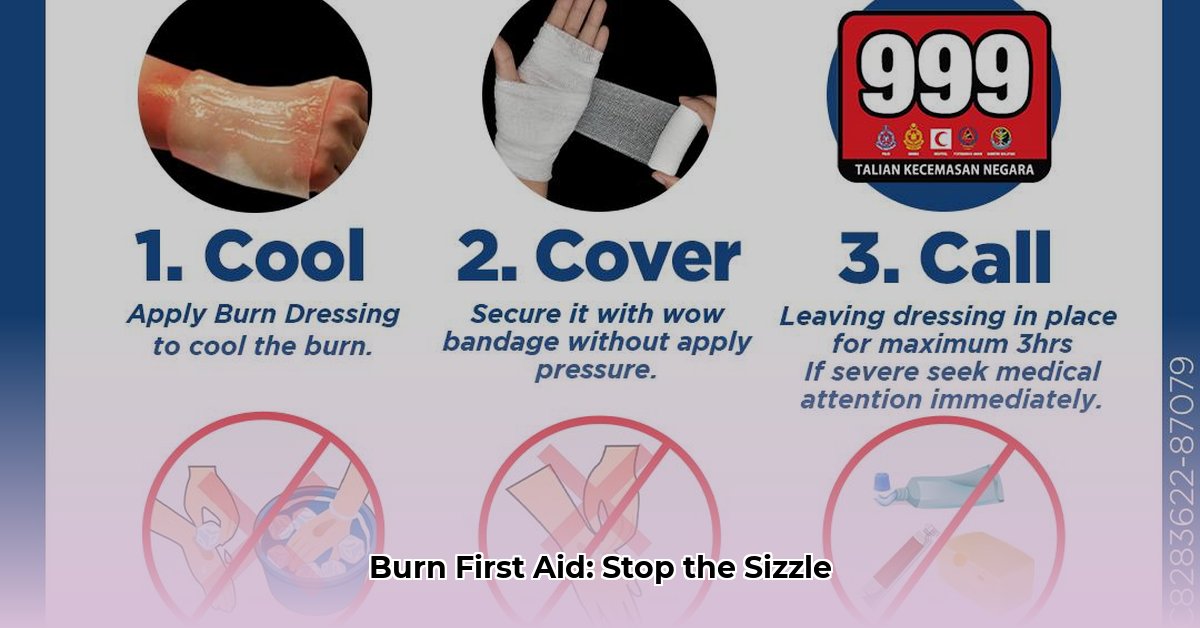Quick Guide to Burn Care
This guide provides essential first aid information for burns. Always consult with a healthcare professional for personalized advice, as ongoing research may offer new insights and treatments.
| Burn Degree | Appearance | Symptoms | First Aid |
|---|---|---|---|
| 1st Degree | Red, painful, may be slightly swollen | Mild pain | Cool water, aloe vera, over-the-counter pain relievers |
| 2nd Degree | Red, blisters, painful | Intense pain | Cool water, do not break blisters, loosely bandage, seek medical advice if large or on sensitive areas |
| 3rd Degree | Charred, white, leathery, may appear waxy | Little to no pain, may have numbness | Call 911 immediately, loosely cover with a sterile cloth if available |
Understanding Burn Types
Burns are classified by their depth, which indicates the extent of damage. Think of your skin like the layers of an onion. A first-degree burn affects the outermost layer, while a third-degree burn penetrates all layers and potentially damages underlying tissue.
First-Degree Burns: Surface Damage
Similar to a mild sunburn, first-degree burns affect only the outer skin layer. They cause redness, mild pain, and possibly slight swelling. Cooling the burn under cool (not icy) running water for 10-15 minutes is usually sufficient. Applying aloe vera gel afterward can provide additional relief. Over-the-counter pain relievers, such as ibuprofen or acetaminophen, may also help manage discomfort.
Second-Degree Burns: Blistering Burns
Second-degree burns penetrate deeper, damaging multiple skin layers. Blisters are a key characteristic, acting as the body’s natural protective barrier. Do not pop these blisters. Cool the burned area under cool running water for 10-20 minutes. Don’t apply ice directly, which could restrict blood flow and worsen the damage. After cooling, loosely cover the burn with a sterile, non-stick bandage. If the burn is large (bigger than three inches across), located on sensitive areas like the face, hands, feet, or genitals, or covers a joint, seek medical advice.
Third-Degree Burns: Deep Tissue Damage
Third-degree burns are the most severe, extending through all skin layers and potentially damaging underlying tissue, muscle, or bone. The area might appear charred, waxy white, or leathery, and may have little or no pain due to nerve damage. Call 911 or your local emergency number immediately. Do not attempt to treat a third-degree burn yourself. Cover the burn loosely with a sterile cloth or clean sheet if available until professional help arrives.
Step-by-Step First Aid for Burns
-
Stop the Burning Process: Immediately remove the source of the burn. Extinguish flames, rinse away chemicals (see specific instructions below), or ensure the power source is off for electrical burns.
-
Cool the Burn: Run cool (not cold or icy) water over the burned area for 10-20 minutes. This helps dissipate heat, reduce pain, and minimize swelling.
-
Assess the Burn: Determine the burn’s severity (first, second, or third-degree). This will guide further treatment.
-
Remove Restrictive Items: Gently remove any jewelry, clothing, or other items that could constrict the area as it swells.
-
Cover the Burn: Loosely cover the burn with a sterile, non-stick dressing or a clean cloth. Cling film can be a temporary option for minor burns, providing a protective barrier.
-
Pain Management: Over-the-counter pain relievers like ibuprofen or acetaminophen can help alleviate pain. Follow the recommended dosage.
Special Cases: Chemical and Electrical Burns
Chemical Burns
For chemical burns, immediately flush the affected area with copious amounts of cool running water for at least 15-20 minutes, or as directed by Poison Control (800-222-1222). Remove any contaminated clothing. If the chemical is a dry powder, brush it off before rinsing. Protect yourself from contact with the chemical.
Electrical Burns
Electrical burns can cause significant internal damage despite a potentially small external appearance. Seek immediate medical attention for all electrical burns.
When to Seek Medical Attention
While many minor burns can be treated at home, some require professional medical care:
- Third-degree burns: Always.
- Second-degree burns: If larger than three inches, located on the face, hands, feet, genitals, or over a major joint.
- Any burn causing difficulty breathing or loss of consciousness.
- Chemical or electrical burns.
- Signs of infection: Increasing pain, redness, swelling, pus, red streaks, or fever.
Burn Prevention Tips
Preventing burns is crucial. Consider these safety measures:
- Kitchen safety: Be careful around hot stoves, ovens, and scalding liquids. Keep pot handles turned inward and use oven mitts.
- Water heater: Set the temperature below 120°F to prevent scalds.
- Electrical safety: Cover unused outlets and keep electrical appliances away from water.
- Fire safety: Install and maintain smoke detectors. Store flammable materials safely.
- Sun safety: Use sunscreen, wear protective clothing, and seek shade during peak sun hours.
Burn Aftercare
Proper aftercare promotes healing and minimizes scarring:
- Keep the burn clean and dry.
- Change dressings as directed by a healthcare professional.
- Avoid picking at scabs.
- Protect the burn from the sun.
- Watch for signs of infection.
- Follow up with a doctor as needed.
Disclaimer: This information is for educational purposes only and does not constitute medical advice. Always consult with a qualified healthcare provider for any health concerns or before making any decisions related to your health or treatment.
- Bento Box Trays Streamline Restaurant Meal Presentation and Transport - December 13, 2025
- Plastic Bento Boxes Face Scrutiny Over Sustainability Impacts - December 11, 2025
- Bento Tray Revolutionizes Organized Meal Transport and Presentation - December 10, 2025










